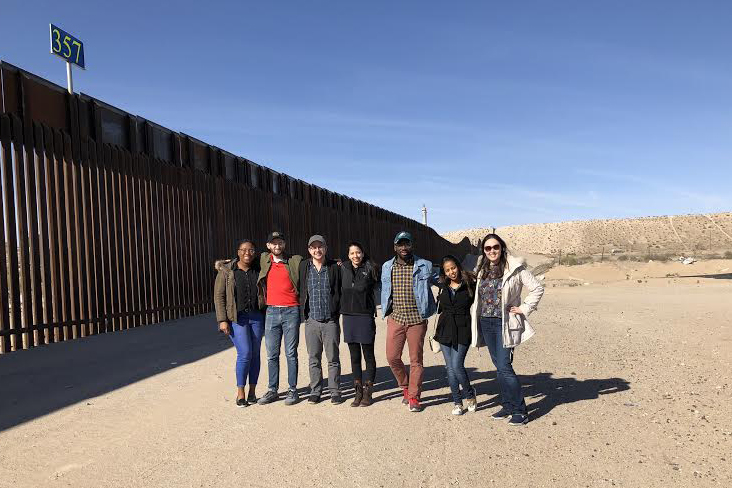GW Law strives to provide creative and innovative opportunities for students to learn and grow beyond the traditional clinics and pro bono opportunities. In March 2018, members of the GW Law Immigration Law Association (ILA) traveled to the United States/Mexico border to participate in a border immersion program to learn about immigration and border issues impacting the United States. We spent most of our time in the border town of El Paso, TX where we had the opportunity to gain an intimate understanding of the process involved in immigrating to the United States.
One part of that process is the role played by the federal government and the courts in adjudicating immigration matters. We visited the El Paso Immigration Court and the Texas Western District Court. At Immigration Court, we observed master calendar hearings and later had lunch with Judge Robert Hough and the representing attorneys. At District Court, we watched an initial appearance hearing and spoke with Magistrate Judge Anne Berton and her law clerks.
To gain a better understanding of the legal and administrative process, we went to the Diocesan Migrant & Refugee Services (DMRS), an immigration legal aid clinic that services low-income immigrants and refugees. Our group learned about the different types of visas, who can apply for them, and about the back-log of visa processing at the State Department. Later that week, a few of us went to volunteer at DMRS and the rest of us went to Las Americas, a non-profit organization dedicated to serving the legal needs of low income immigrants.
Our group also met with Border Patrol and had the opportunity to ask questions. We asked the officer questions about discretion, the anticipated wall, the current level of border security, and the decades-long backlog of people awaiting visas. Susan Ali (3LE) said, "When asked about the wall, the Border Patrol agent acknowledged that there was no method that is 100% effective to protect the border – we can read between the lines on that response. It was also surprising that he acknowledged gaps in the current immigration system and suggested that Congress needed to fix the system to address issues like the backlog."
At this point of the trip, we had been exposed to the legal aspects of the immigration process, but it is imperative to remember these are people, not cases. We toured the Annunciation House, a shelter for undocumented immigrants without homes. Coordinated entirely by volunteers, the Annunciation House and its network of shelters exists to assist and temporarily house the migrant, homeless, and economically vulnerable people of the El Paso-Juarez border region. Evan Hunt (1L) said, "What surprised me most about the Annunciation House was how much the volunteers were willing to give up. Some of the volunteers had careers and moved their entire lives just to help others."
The Annunciation House receives over 1000 migrants each week, most of them Central American migrants who have just been processed and released by Immigration and Customs Enforcement officials. While hearing from the founder of the Annunciation House, Joseph Quarcoo (3LE) explained, "I was reminded of how closely connected those of us who live in the interior of the United States are to the border and to the issues affecting communities at the border. Immigrants are not taking American jobs, but rather augmenting the industries which the rest of the United States workforce needs to even have produce for dinner or to have their elderly taken care of…"
Throughout the week, we heard stories from members of the immigrant community – some of whom were undocumented and some the children of undocumented people. We went to the home of an undocumented woman and her family who lived in a colonia - rural settlements along the border that typically lack basic infrastructure - and heard her story of how her family fled danger in Mexico to keep their children safe.
By the end of the trip, with consensus, our group came to a conclusion regarding two realities. First, the current immigration policies and their implementation leave much to be desired, and second reforming immigration laws and legal advocacy are means by which to effectuate the much-needed changes. Christian Kuzdak (1L) says that "Speaking with undocumented people and hearing their stories made it clear that something has to change, and that I need to be part of it." Sasha Marseille (1L) shared an account of her own history with immigration saying, "I often take for granted the advantages I have as a natural born U.S citizen. My parents emigrated from Haiti and had to navigate through the complicated and lengthy immigration process, eventually worked their way to getting their citizenship. They are two examples of the US immigration system working..." When asked about her experience, Sarah Turrittin (3L) says, "With the new administration there are new fears among the immigrant community, and more frustrations within the legal community. The majority opinion from both the immigrant and legal community is that the broken immigration law needs a complete overhaul."


